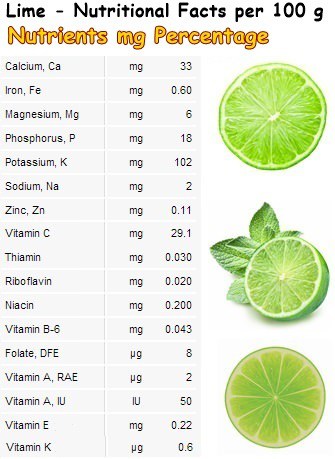It is said that 19th century Royal Navy British sailors relied immensely on limes to prevent possibly the most dreaded disease that could befall a seaman: scurvy. Despite the lack of scientific evidence at the time, trial and error made it possible for sailors of that era to enjoy one of the many health benefits of lime: its excellent vitamin C content.
They were such avid consumers of the fruit that the world came to know them as ‘lymeys’. And although limes do not have the best nutritional value compared to other fruits, they still have boast anti-inflammatory and antimicrobial effects.
Research has given us evidence of the benefits of eating citrus fruit, lime included. The fruit boasts a varied nutritional profile, with good amounts of vitamin C and B vitamins, potassium, phosphorus and calcium.
Limes are known for their antioxidant, anti-inflammatory and antibacterial action, as well as immune-boosting and anticancer properties. And unless you have gastrointestinal problems such as acid reflux, heartburn, gastritis or ulcers, they are quite wonderful options.

What do lime fruit look and taste like?
Lime is a beautiful, bumpy green citrus fruit, somewhat round and smaller than a lemon. Taste and rind thickness may differ slightly depending on the variety. While some fruits have a thin rind, others varieties have a rind just as thick as that of lemons.
Limes are famous for their acidic taste, comparable to that of lemons, yet not as strong and sour. Sweeter lime varieties are usually crossed with other citrus fruit for a more tempered flavor. Because the most valuable nutritional property of limes is their vitamin C content, they hold the most benefits when eaten raw.
Cooking limes or lime juice destroys all the vitamin C content, taking away from the anti-inflammatory, antimicrobial and antioxidant properties of the fruit.
Popular lime varieties include:
- Persian lime (Citrus latifolia), the most common variety, larger in size, seedless and somewhat less bitter, less acidic than the others
- Key lime (Citrus aurantifolia)
- Makrut lime (Citrus hystrix)

What are the benefits of lime fruit?
Limes, lemons, and citrus fruit in general are healthy. We all know it and make efforts to include them in our regular diet. But what makes citrus fruit healthy? What makes limes in particular healthy? Let’s find out.
See below my list of the top 8 nutrition facts and health benefits of limes.
Important role in cancer prevention
Limes contain limonoids, compounds said to help in the prevention of skin, mouth, stomach, breast and lung cancer. According to an article published in the Journal of Agricultural and Food Chemistry, limonin, a limonoid present in lime and other citrus fruit such as oranges, has exhibited rather impressive antitumor activity, inducing apoptosis (programmed cell death) in cancer cells.
Moreover, lime is a great source of vitamin C, only 100 g of fruit supplying around 33% of the RDA of this essential nutrient. Vitamin C reduces cancer risks by protecting cells from free radical damage and by significantly reducing chronic inflammation, a factor known to play a pivotal role in cancer development. However, remember that bad dietary and lifestyle choices matter just as much as good ones, so make sure you enjoy an overall good diet, rich in nutrients and full of variety, as well as good lifestyle habits (more sleep, less stress, sufficient exercise).
High antioxidant content
Lime is a valuable source of antioxidants, vitamins included. Potent phytochemicals and flavonoids scavenge for and destroy reactive oxygen molecules called free radicals, preventing their harmful action on healthy cells and DNA. Why is this important? Because antioxidants prevent damage that can cause healthy cells to go rogue and start multiply uncontrollably becoming cancer cells, instead allowing them to live out their set lifespan working to keep us healthy.
Secondly, antioxidants help keep artery walls healthy, fat-free and prevent heart disease, even influencing the rate at which we age, slowing down certain cellular processes and delaying aging signs such as premature wrinkles, gray hair, iris discoloration or vision loss.

Valuable source of vitamin C
100 of lime pulp supplies us with about 33% of the RDA of vitamin C, whereas lime juice provides slightly more (46%). A good dietary intake of vitamin C helps prevent scurvy, boosts immunity, promotes artery and heart health, reduces the frequency and severity of viral infections as well inflammation levels and increases collagen production, resulting in beautiful, youthful, wrinkle-free skin. Limes can make a good food to eat for arthritis as a result of the anti-inflammatory benefits of vitamin C. See what are the foods to eat and to avoid for arthritis.
Antibiotic properties
Several studies conducted in West Africa showed that introducing limes in villagers’ diets significantly reduced cholera infection rates. This is theorized to be a result of the nutrient’s antimicrobial and immune-boosting properties.
Strengthens the immune system
Regular consumption of lime is said to greatly increase our immune system’s response to the common cold and flu viruses. This is mostly a result of the fruit’s generous vitamin C content which increases white cell aggressiveness, better equipping the body to fight off infection.
Anti-inflammatory activity
It has been suggested that lime and lime juice, which boasts a higher concentration of nutrients, have significant anti-inflammatory effects, reducing chronic inflammation, arthritis, heart disease and asthma risks. A study published in the Annals of Rheumatic Diseases, conducted on 20, 000 subjects, revealed that subjects who ate generous amounts of vitamin C-rich foods had 3 times less risks of developing rheumatoid arthritis than the subjects who had a poor vitamin C intake.
Benefits for cardiovascular health
Both an anti-inflammatory and a great source of vitamin C, lime is said to be one of those foods which contribute immensely to cardiovascular health. More exactly, regular consumption is said to benefit the entire cardiovascular system, maintaining blood vessel integrity and cardiac muscle health, reducing blood cholesterol levels and preventing lipid peroxidation.
Good for eyesight and eye health
Thanks to its generous content of vitamin C, lime is said to contribute to the prevention of cataract and other degenerative eye conditions. This is because of the antioxidant properties of the citrus fruit, which prevent free radical damage at the level of the retina.
What are the side effects of Lime?
No food is devoid of side effects, limes included. Eating too many limes or drinking too much lime juice, or sometimes even small intakes, can cause stomach pain, acid reflux or regurgitation of stomach juices, associated heartburn, a bad metallic or acidic taste in the mouth and bad breath as a result of the reflux. Consumption of lime and lime juice can cause GERD and gastritis flareups as well as teeth sensitivity and tooth pain because of the organic acids in the fruit and fruit juice wearing off tooth enamel.
